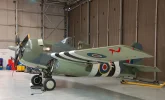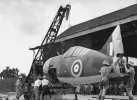Brewsteriako tuossa kakkoskuvassa puretaan laatikosta ? Ottivat japseilta kunnolla pataan Singaporessa, kun lähtivät vääntämään noilla kurvatappelua.
Ensimmäistä kertaa selvitin itselleni, että mikä täsmälleen ottaen briteillä mätti Brewsterin kanssa. Näyttäisi siltä, että monen tekijän summa aiheutti tappiot. Luettelo näyttää itse asiassa aika masentavalta. Ja samalla kiintoisalta, aina sitä oppii kaikenlaista uutta.
https://en.wikipedia.org/wiki/Brewster_F2A_Buffalo
British Commonwealth (Malaya)
Brewster B-339E (AN196/WP-W) of
No. 243 Squadron RAF. This aircraft was flown by
Flying Officer Maurice Holder, who flew the first Buffalo sortie in the
Malayan Campaign on 8 December 1941, strafing
landing barges on the
Kelantan River.
[41] Damaged by ground fire, it was abandoned at
RAF Kota Bharu before its fall to the Japanese.
[41]
The B-339E, or Brewster Buffalo Mk I as it was designated in British service, was initially intended to be fitted with an export-approved Wright R-1820-G-105 Cyclone engine with a 1,000 hp (745.7 kW) (peak takeoff) engine.
[42][N 8] The Brewster aircraft delivered to British and Commonwealth air forces were significantly altered from the B-339 type sold to the Belgium and French forces in accordance with their purchase order. The Brewster factory removed the Navy
life raft container and
arrestor hook, while adding many new items of equipment, including a British Mk III
reflector gun sight, a gun camera, a larger fixed pneumatic tire tail wheel, fire extinguisher, engine shutters, a larger battery, and reinforced armor plating and armored glass behind the canopy windshield.
[43]
The Brewster Model B-339E, as modified and supplied to Great Britain was distinctly inferior in performance to the F2A-2 (Model B-339) from the original order. It had a less powerful (1,000 hp (745.7 kW)) engine compared to the F2A-2's 1,200 hp (895 kW) Cyclone, yet was substantially heavier due to all of the additional modifications (some 900 lb/400 kg). The semi-retractable tail wheel had been exchanged for a larger fixed model, which was also less aerodynamic. Top speed was reduced from 323 mph (520 km/h) to 313 mph (504 km/h) at combat altitudes.
[11
Brewster B-339E wrecks cannibalized for parts, probably in Singapore circa late January 1942. Two of the Buffalos, serials W8156 and W8207, were operated by 453 Squadron RAAF.
[44]
In its original form, the B-339 had a theoretical maximum speed of 323 mph (520 km/h) at a rather unrealistic 21,000 ft (6,400 m), but fuel starvation problems and poor supercharger performance at higher altitudes meant that this figure was never achieved in combat; the B-339E was no different in this regard. Its maneuverability was severely impaired (the aircraft was unable to perform loops), and initial rate of climb was reduced to 2,300 ft/min. The Wright Cyclone 1890-G-105 engine designated for use in the Brewster Mk I was in short supply; many aircraft were fitted with secondhand Wright engines sourced from Douglas DC-3 airliners and rebuilt to G105 or G102A specifications by Wright.
[40] In service, some effort was made by at least one Brewster squadron to improve the type's sluggish performance; a few aircraft were lightened by some 1,000 lb (450 kg) by removing armor plate, armored windshields, radios, gun camera, and all other unnecessary equipment, and by replacing the .50 in (12.7 mm) machine guns with .303 in (7.7 mm) machine guns.
[45] The fuselage tanks were filled with a minimum of fuel, and run on high-octane aviation petrol where available. At Alor Star airfield in Malaya, the Japanese captured over 1,000 barrels (160 m3) of high-octane aviation petrol from British forces, which they promptly used in their own fighter aircraft.
[46]
Many of the pilots assigned the Buffalo lacked adequate training and experience in the type. A total of 20 of the original 169 Buffalos were lost in training accidents during 1941. By December 1941, approximately 150 Buffalo B-339E aircraft made up the bulk of the British fighter defenses of Burma, Malaya and Singapore. The two RAAF, two RAF, and one RNZAF squadrons, during December 1941-January 1942, were beset with numerous problems,
[47] including poorly built and ill-equipped aircraft.
[11] Aviation historian Dan Ford characterized it as, "The performance... was pathetic." Inadequate spare parts and support staff, airfields that were difficult to defend against air attack, lack of a clear and coherent command structure, a
Japanese spy in the Army air liaison staff, antagonism between RAF and RAAF squadrons and personnel, and inexperienced pilots lacking appropriate training would lead to disaster. Although the Mk I had .50-inch guns, many aircraft were equipped with .30 Browning mounts and electric firing solenoids, which tended to fail in service.
[40]
When the Japanese invaded
northern Malaya on 8 December 1941, the B-339E initially performed adequately. Against the
Nakajima Ki-27 "Nate", the overloaded Brewsters could at least hold their own if given time to get to altitude, and at first achieved a respectable number of kills. However, the appearance of ever greater numbers of Japanese fighters, including markedly superior types such as the
Nakajima Ki-43 "Oscar" soon overwhelmed the Buffalo pilots, both in the air and on the ground. Another significant factor was the Brewster engine's tendency to overheat in the tropical climate, which caused oil to spray over the windscreen, usually forcing an aborted mission and greatly complicating attempts to intercept and destroy enemy aircraft. In the end, more than 60 Brewster Mk I (B-339E) aircraft were shot down in combat, 40 destroyed on the ground, and approximately 20 more destroyed in accidents. Only about 20 Buffalos survived to reach India or the
Dutch East Indies.
[49]
It is not entirely clear how many Japanese aircraft the Buffalo squadrons shot down, although RAAF pilots alone managed to shoot down at least 20.
[50] Eighty were claimed in total, a ratio of kills to losses of just 1.3 to 1. Additionally, most of the Japanese aircraft shot down by the Buffalos were bombers.
[40] The
Hawker Hurricane, which fought in Singapore alongside the Buffalo from 20 January, also suffered severe losses from ground attack; most were destroyed.
[51] The
Fleet Air Arm also used the Buffalo in the Mediterranean in the
Battle of Crete in early 1941.
Edit: tuo viimeinen lause on kyllä täysin uusi juttu minulle.
























